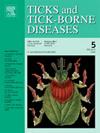Using meta-analysis to estimate the incidence of Lyme borreliosis clinical manifestations in Denmark, Ireland and Sweden based on publicly-available Lyme neuroborreliosis data
IF 3.4
2区 医学
Q2 INFECTIOUS DISEASES
引用次数: 0
Abstract
Lyme borreliosis (LB) is the most common tick-borne disease in Europe and can manifest as localized erythema migrans (EM) or further disseminate into Lyme neuroborreliosis (LNB), Lyme arthritis (LA) or other manifestations. However, public health surveillance in Denmark and Ireland only captures LNB, while published LB data for Sweden only includes LNB. To enhance the understanding of LB disease burden in these countries, this study aimed to estimate LB incidence by clinical manifestation using the ratio of each manifestation to LNB. These ratios were derived using random effects meta-analysis of published data from other European countries. We estimated the ratios for EM/LNB, LA/LNB and other manifestations/LNB to be 42.8 (95 % confidence interval [CI]: 36.4–50.4), 0.9 (95 % CI: 0.7–1.0), and 0.8 (95 % CI; 0.4–1.4), respectively. Applying these ratios to the LNB incidence resulted in an estimated overall LB incidence of 151.5 cases per 100,000 population per year (PPY) in Denmark, 285.2 per 100,000 PPY in Sweden and 9.5 per 100,000 PPY in Ireland. These correspond to >36,000 LB cases per year compared to approximately 800 LNB cases reported in these three countries. Furthermore, the estimated incidence of disseminated manifestations was 8.7 and 16.4 per 100,000 PPY in Denmark and Sweden, respectively. These estimates across LB manifestations highlight the LB health burden on the national healthcare systems. Future studies that directly estimate the incidence of medically-attended LB from healthcare registries, claims data or administrative medical records may help validate these estimates.
基于公开的莱姆病神经螺旋体病数据,采用荟萃分析估计丹麦、爱尔兰和瑞典莱姆病临床表现的发病率
莱姆病(Lyme borreliosis, LB)是欧洲最常见的蜱传疾病,可表现为局部移行性红斑(EM)或进一步传播为莱姆病神经螺旋体病(Lyme neuroborreliosis, LNB)、莱姆病关节炎(Lyme arthritis, LA)或其他表现。然而,丹麦和爱尔兰的公共卫生监测仅捕获LNB,而瑞典公布的LB数据仅包括LNB。为了加强对这些国家LB疾病负担的了解,本研究旨在通过临床表现估计LB发病率,使用各种表现与LNB的比例。这些比率是通过对其他欧洲国家发表的数据进行随机效应荟萃分析得出的。我们估计EM/LNB, LA/LNB和其他表现/LNB的比率为42.8(95%可信区间[CI]: 36.4-50.4), 0.9 (95% CI: 0.7-1.0)和0.8 (95% CI;分别为0.4 - -1.4)。将这些比率应用于LNB发病率,结果估计丹麦的LB总发病率为每10万人每年151.5例,瑞典为每10万人每年285.2例,爱尔兰为每10万人每年9.5例。这相当于每年36000例LB病例,而这三个国家报告的LB病例约为800例。此外,在丹麦和瑞典,播散性表现的估计发病率分别为每10万PPY 8.7和16.4。这些横跨LB表现的估计突出了LB对国家医疗保健系统的健康负担。未来的研究将从医疗保健登记、索赔数据或行政医疗记录中直接估计医疗护理LB的发生率,这可能有助于验证这些估计。
本文章由计算机程序翻译,如有差异,请以英文原文为准。
求助全文
约1分钟内获得全文
求助全文
来源期刊

Ticks and Tick-borne Diseases
INFECTIOUS DISEASES-MICROBIOLOGY
CiteScore
6.90
自引率
12.50%
发文量
185
审稿时长
6-12 weeks
期刊介绍:
Ticks and Tick-borne Diseases is an international, peer-reviewed scientific journal. It publishes original research papers, short communications, state-of-the-art mini-reviews, letters to the editor, clinical-case studies, announcements of pertinent international meetings, and editorials.
The journal covers a broad spectrum and brings together various disciplines, for example, zoology, microbiology, molecular biology, genetics, mathematical modelling, veterinary and human medicine. Multidisciplinary approaches and the use of conventional and novel methods/methodologies (in the field and in the laboratory) are crucial for deeper understanding of the natural processes and human behaviour/activities that result in human or animal diseases and in economic effects of ticks and tick-borne pathogens. Such understanding is essential for management of tick populations and tick-borne diseases in an effective and environmentally acceptable manner.
 求助内容:
求助内容: 应助结果提醒方式:
应助结果提醒方式:


